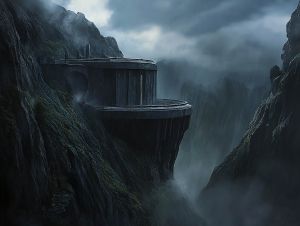Vul Thak's Gate
| Vul Thak's Gate | |
|---|---|
| Image |  |
| Type | Mountain Outposts in the Sanctuary Vale |
| Location | Eastern Murazkar Range |
| Realm | Kar-Thal |
| Controlled by | Council of Stone |
| Significance | Primary surface checkpoint between Kar-Thal and the Deep Road |
Introduction
Vul Thak’s Gate is a fortified Duranthi outpost in the Sanctuary Vale situated high in the eastern Murazkar Range. Built into a wind-carved ridge, it marks the last above-ground station before travelers descend into the Deep Road toward Telenkar Hold and Dul-Val. Known for its severe climate, silent customs, and threshold rites, it serves as both a watchpost and an atmospheric transition point for deepbound journeys.
Geography
The Outposts in the Sanctuary Vale is perched along a saddle ridge between jagged basalt peaks, exposed to sharp alpine winds and mist from the lower eastern crags. Its walls are carved directly into the rock, reinforced with sun-darkened ironstone and slate. A narrow stone stair called the “Spine of Entry” leads to a lower gallery that conceals the Deep Road entrance. From its upper tier, one can see the distant shimmer of Kar-Thal’s outer towers.
History
Established during the early days of Great Road expansion, Vul Thak’s Gate originally served as a warden outpost in the Sanctuary Vale for surface patrols. Its role shifted over time into a logistical threshold for Deep Road entry. Named for an stonewarden who died sealing a breach in the eastern tunnels.
Functions and Features
The outposts in the Sanctuary Vale includes the following key structures:
- Wind Shrine – A circular sky-facing chamber.
- Gatehall – The fortified hall where travel clearances are issued.
- Watcher’s Spine – A tiered balcony where deep scouts monitor for surface anomalies or signs from Kar-Thal.
- Subduct Hatch – A massive stone hatch that seals the Deep Road entry.
Defenses and Watch
Though not large, Vul Thak’s Gate is heavily fortified and constantly manned by stonewardens. Its wind-exposed location makes siege unlikely, and its harmonic wards are calibrated to detect both physical and resonance anomalies.